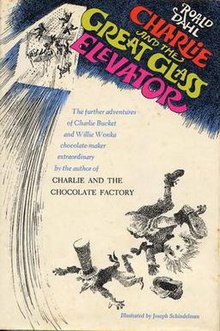Charlie and the Great Glass Elevator
 Charlie and the Great Glass Elevator
Charlie and the Great Glass ElevatorCharlie and the Great Glass Elevator is a children's book by British author Roald Dahl. It is the sequel to Charlie and the Chocolate Factory, continuing the story of young Charlie Bucket and eccentric chocolatier Willy Wonka as they travel in the Great Glass Elevator.
Charlie and the Great Glass Elevator was first published in the United States by Alfred A. Knopf, Inc. in 1972, and in the United Kingdom by George Allen & Unwin in 1973.
Unlike its predecessor, this book has never been adapted to film. Willy Wonka & the Chocolate Factory (1971) disappointed Dahl to the point that he refused to have a film version produced.Tim Burton and Johnny Depp have announced that they have no intention of producing a sequel to Charlie and the Chocolate Factory (2005), although elements from Charlie and the Great Glass Elevator are seen at the end of the film.
Dahl had intended to write a third book in the series but never finished it.
The story picks up immediately where the previous book left off, with Charlie and his whole family (including the three grandparents still in bed) aboard the flying Great Glass Elevator, en route to the Chocolate Factory which Mr. Wonka intends to give to Charlie. The dizzying height to which the Elevator ascends frightens Charlie's family, especially Grandma Josephine, who panics and prevents Mr. Wonka from reversing direction. As a result, the Elevator goes into orbit about the Earth, where - making the best of a bad situation - Mr. Wonka decides to dock with a newly launched Space Hotel.
In the White House, President Lancelot R. Gilligrass, Vice President Elvira Tibbs, the president's best friend, chiefs, and the U.S. Cabinet see the Elevator dock with the Space Hotel, and fear it contains hostile agents of a foreign or extraterrestrial government, while the space shuttle containing the hotel staff and three astronauts approaches the Space Hotel. On the Hotel, Wonka and the others hear the President address them across a radio link as Martians, and Wonka therefore teases Gilligrass with nonsense words and grotesque poetry. In the midst of this, the hotel's own elevators open, revealing five gigantic amoeba-like monsters, which change shape: each forming a letter of the word 'SCRAM'. Recognising the danger, Mr. Wonka orders everybody off the Space Hotel. These shape-changers, Mr. Wonka tells the others, are predatory extraterrestrials called Vermicious Knids, waiting in the Space Hotel to consume its staff and guests. Mr. Wonka also explains that the Knids have tried to invade Earth and consume its inhabitants like they have done with many other planets (Mars, Venus and the Moon, among others) but are always incinerated because of the atmosphere protecting the planet.
...
Wikipedia